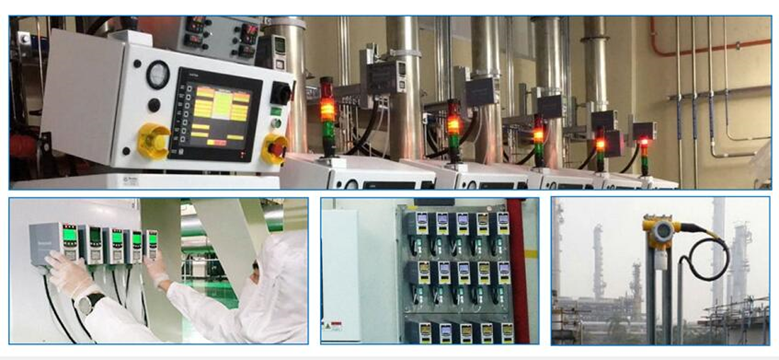GMS Gas Monitoring System
The GMS gas monitoring system is a powerful system designed to ensure the safety of production environments. The system mainly consists of two parts: the field-installed flammable/toxic gas detectors and the control unit, data acquisition module, and workstation located in the control room.
During the operation of the system, the flammable/toxic gas detectors installed on-site are responsible for real-time detection of various gas concentrations in the production environment. Once a change in gas concentration is detected, the detectors immediately convert the collected gas concentration information into analog signals.
Subsequently, the data acquisition module receives these analog signals and transmits them to the GDS control unit located in the control room through serial communication. The control unit processes the received signals and compares them with preset alarm upper/lower limit values. When the gas concentration detected by a detector exceeds the upper limit or falls below the lower limit, the control unit outputs an alarm signal through the DO module.
Moreover, the system possesses the capability to integrate and exchange information with other branded system devices (platforms) through industrial standard communication protocols, platforms, and interfaces. This includes protocols such as MODBUS, TCP/IP, and OPC, enabling seamless connection and broader data sharing and collaborative work between the GMS gas monitoring system and other systems.
Overall, the GMS gas monitoring system provides robust protection for the safety of production environments through its efficient data acquisition, processing, and communication capabilities. It plays a crucial role in various industries that require gas concentration monitoring, such as chemicals, oil and gas, pharmaceuticals, semiconductors, and more.
The GMS gas monitoring system boasts a wide range of application scenarios, with its core function being the real-time detection and monitoring of gas concentrations in various environments, and timely alerting in case of abnormalities to ensure personnel safety and the continuity of industrial production. Here are some specific application scenarios:
Monitoring in Chemical Plant Areas: In the critical production areas of chemical plants, the GMS gas monitoring system is used to monitor potential leaks of harmful gases in real-time. When the system detects that the concentration of a dangerous gas exceeds the safety limit, it immediately initiates emergency response plans, including ventilation and evacuation measures, effectively preventing accidents from occurring.
Safety Monitoring in Storage Areas: The GMS gas monitoring system also plays a vital role in raw material and finished product storage areas. Through continuous monitoring of gas concentrations in these areas, the system can promptly detect any gas leaks that may occur due to improper storage, enabling timely safety measures to be taken to ensure storage safety.
Emission Monitoring and Environmental Compliance: The GMS gas monitoring system can also be used to monitor the gases emitted by chemical plants into the atmosphere, ensuring that emissions comply with environmental standards. This is crucial for maintaining environmental quality and meeting regulatory requirements.
Gas Monitoring in Underground Utility Tunnels: In underground utility tunnels, the GMS gas monitoring system monitors the environmental conditions of flammable and toxic gases. Upon detecting any abnormalities, the system promptly issues audible and visual alarms and transmits data to the control center, allowing for the activation of the corresponding exhaust system to ensure safety within the tunnel.
Gas Supply Monitoring in Semiconductor Factories: In semiconductor factories, the GMS gas monitoring system enables real-time monitoring of the status of gas supply equipment, such as pipeline pressure and valve status. This helps to promptly identify any equipment abnormalities, safeguarding the stability of the production process and product quality.
With the continuous advancement of technology and expansion of application fields, the scenarios for the GMS gas monitoring system are expected to further diversify. In the future, the system may become more intelligent, high-precision, and integrated, adapting to more complex and variable environmental needs

 EN
EN
 AR
AR
 HR
HR
 CS
CS
 NL
NL
 FR
FR
 DE
DE
 IT
IT
 JA
JA
 KO
KO
 NO
NO
 PL
PL
 PT
PT
 RO
RO
 RU
RU
 ES
ES
 SV
SV
 TL
TL
 ID
ID
 VI
VI
 MT
MT
 TH
TH
 TR
TR
 AF
AF
 MS
MS
 AZ
AZ

